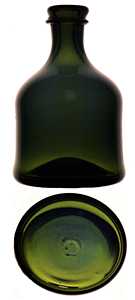
French Wine Bottle made in the 1700s (Reproduction)
Bottle 1 was reproduced from eighteenth-century (1700-1800)
fragments excavated by archaeologists at the site of the colonial
Illinois village of Cahokia The bottle was
made by Glass Elite, a company that specializes in producing
hand-blown, reproduction glass objects.
The bottle was
made by Glass Elite, a company that specializes in producing
hand-blown, reproduction glass objects.
To make this bottle, the people at Glass Elite followed the same
procedure that French bottlemakers used in the 1700s. The resulting
dark green, hand-blown bottle is characteristic of the wine bottles
shipped from France to New Orleans and Illinois for people on the
French Frontier.
 French wine bottles were made by a glassmaker and his assistant
following this procedure:
French wine bottles were made by a glassmaker and his assistant
following this procedure:
- Sand and wood ash are melted in giant iron pots placed on a
red-hot flame to form molten glass. Sand could be made from a
variety of crushed rocks ranging from very expensive to very cheap.
The cheaper the sand, the greener the glass.
- The assistant gathers a mass of molten glass on the end of a
hollow blowing pipe and inflates it like a soap bubble into a mold.
Molds enabled bottlemakers to mass-produce bottles that held the
same amount of liquid.
- The assistant transfers the bottle from the blower's pipe to
the pontil-iron.
- The pontil-iron is used to support the bottle while the
glassmaker forms the neck of the bottle. The pontil-iron is also
used to push the base of the bottle up into its interior, forming
the "Kick-up." The kick-up served two purposes: to make the bottle
stronger and to catch the dregs of the wine--solid matter left over
from the wine-making process.
- The bottle is removed from the pontil-iron, leaving a pontil
scar on the base of the bottle, and then left to harden as the
glass cools.
Summary: There are several characteristics of this bottle
that reveal how it was made--using hand-blown techniques and in the
style of French wine bottles from the 1700s:
- the color and texture of the glass
- the pontil-scar on the base of the bottle
- the base or "kick-up" of the bottle
You can click on the bottle to get a closer look.
A QuicktimeVR movie of this bottle is
also available. If you need a QuicktimeVR viewer, visit Apple's
QuicktimeVR page at:  https://quicktimevr.apple.com/
https://quicktimevr.apple.com/

© Illinois State Museum
31-Dec-96
![]() The bottle was
made by Glass Elite, a company that specializes in producing
hand-blown, reproduction glass objects.
The bottle was
made by Glass Elite, a company that specializes in producing
hand-blown, reproduction glass objects. French wine bottles were made by a glassmaker and his assistant
following this procedure:
French wine bottles were made by a glassmaker and his assistant
following this procedure: